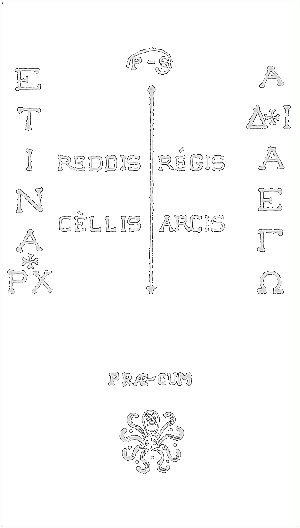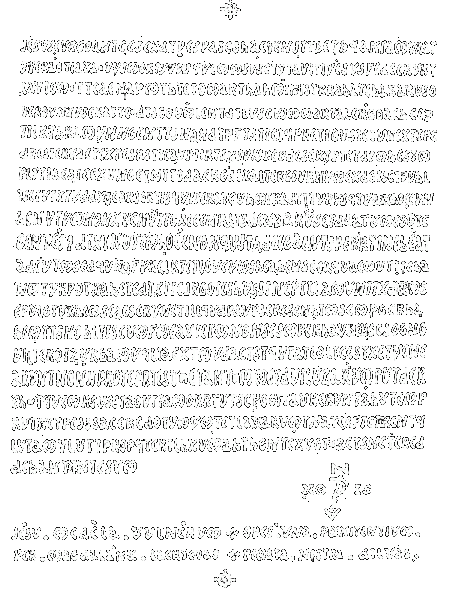|

Contents
Reading Between The
Lines:
The Parchments
by Mark Naples
from
MysteryTV Website
This is perhaps the aspect of the Rennes-le-Château
mystery that has attracted the most interest - and the most
controversy.
The Dossiers secrets claims that Abbé Saunière had found a
collection of parchments hidden in his church. These were supposedly
placed there by his predecessor, Abbé Antoine Bigou, who had
recovered them from an earlier hiding place on the deathbed
instructions of Marie de Nègre d’Ables, Dame de Hautpoul-Blanchefort.
The parchments were said to contain genealogical information
relating to the survival of
the Merovingian bloodline, and extracts
from the Gospels in Latin that contained coded messages.
The genealogical documents have never been made public, although
they are supposed to be one of the sources for ’Henri Lobineau’s’
work on the Merovingian survival that forms the core of the Dossiers
secrets. It is claimed that they were acquired by a group of British
businessmen - with connections to the intelligence services - and
were locked away in a London bank vault until the late 1970s. This
aspect of the mystery is currently the subject of a Mystery.TV
documentary project.
The coded parchments have been published, the first time being in
Gérard de Sède’s 1967 book L’Or de Rennes. How de Sède came by them
is not known for certain - he would only say that he was given them
by someone closely connected with Rennes-le-Château. It has been
speculated that this was either Noël Corbu or Pierre Plantard.
|
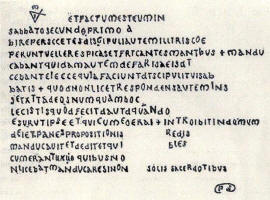
The Dagobert
Parchment |
THE ’DAGOBERT’
PARCHMENT
The text on this parchment, the shorter of the two, is a composite
of different Gospel accounts of Jesus and his disciples eating corn
on the Sabbath. The hidden message was discovered by Henry Lincoln
in 1969. Some of the letters are raised above the rest on the line,
and simply reading them in order gives the words:
A DAGOBERT II ROI ET A SION EST CE
TRESOR ET IL EST LA MORT
In translation:
To Dagobert II, King, and to Sion is
this treasure and he is there dead.
Some have read ’il est la mort’ as ’it
is death’. This reading is possible, but ’he is there dead’ is the
more obvious meaning to a French reader.
The message links four familiar themes from the Dossiers secrets:
the Merovingian king Dagobert II, Sion (presumably a reference to
the Priory of Sion), treasure and the presence of an important dead
body or tomb.
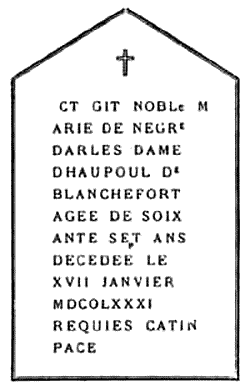
The tombstone of the
Dame d’Hautpoul
THE ’SHEPHERDESS’
PARCHMENT
This had attracted by far the more interest and attempts at
interpretation.
The Latin text is the account from John’s Gospel (chapter 12) in
which Mary of Bethany (believed by many to be one and the same as
Mary Magdalene) anoints Jesus. As with the first parchment, certain
letters are picked out - this time by being
|
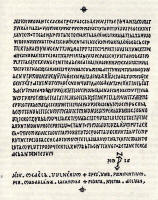
The
“Shepherdess” Parchment |
smaller than the rest - which spell the
words REX MUNDI, Latin for ’King of the World’, a term used by
Gnostic heretics such as
the Cathars.
Letters lowered below the line spell PANIS and SAL - bread and salt.
Letters, inserted apparently randomly into the text and raised above
the line spell AD GENESARETH - ’to Genesareth’ - Genesareth being
another name for the Sea of Galilee.
But there are also 140 completely extraneous letters that have been
inserted here and there throughout the text. When written out they
make a hopeless jumble, apart from the AD GENESARETH phrase in the
middle.
However, by a complicated decoding process meaningful words can be
found. In this process, the inscription on Marie de Nègre d’Ables’s
tombstone is vital, as it provides the necessary keys.
The steps are:
1. Remove the words AD
GENESARETH. This leaves 128 letters.
2. The remaining letters are then put through a classic
ciphering system known as a Vigenère Square (after its creator,
the 16th-century diplomat and esotericist Blaise de Vigenère).
This uses a key word or phrase to encode a message, which the
decoder needs to know (or work out). In this case, the key is
MORT EPEE (’death sword’), which is an anagram of the anomalous
letters on Dame Marie’s headstone.
3. The resulting letters are then moved one place up the
alphabet - A becomes B, etc.
4. The result is then put through another Vigenère
Square. This time the key is the entire text from Dame Marie’s
headstone with the addition of the words PS PRAECUM, which were
supposed to have been inscribed on the second of the two stones
on her grave - the whole of this being written backwards.
5. The letters that emerge from this process are then
shifted one place down the alphabet.
6. The final process is the most intriguing. The letters
are written onto two grids of 64 squares (8 by 8) which are laid
out like chessboards. The letters are then read out in a
sequence determined by what is known as a ’knight’s tour’. In
this, a knight is moved around the board in such a way as to
touch every square on the board once, and no square twice. There
are several versions of the knight’s tour, the one used here
being a variation of that devised by de Moivre.
The final
result of this tortuous process is the message:
BERGERE PAS DE TENTATION QUE POUSSIN
TENIERS GARDENT LE CLEF PAX DCLXXXI PAR LE CROIX ET CE CHEVAL DE
DIEU J’ACHEVE CE DAEMON DE GARDIEN A MIDI POMMES BLEUES
This is at least readable, even if we
are no wiser as to what it means.
Remarkably, this message is a perfect anagram of the inscription on
Dame Marie’s headstone, with the addition of the words PS PRAECUM,
which appear on the second stone said to have been on her grave.
THE CODING
PROCESS
While ingenious, the method of encoding the message (which is, of
course, the reverse of the decoding method shown above) is, in
cryptographical terms, ridiculous. It requires an unnecessary number
of steps, each of which is purely arbitrary, the whim of whoever
devised it.
The result is a code that is unbreakable. Anyone attempting to break
a code has to work out - or guess - the encoding process. The
process used here is so convoluted, unorthodox and arbitrary that it
is simply impossible for a codebreaker to work them out. For
example, one of the keys to the Vigenère Square is the entire text
of Dame Marie’s headstone plus nine letters taken from another
inscription - all of which is written backwards! Not even the most
brilliant codebreaker would think to try this, let alone the use of
the knight’s tour and the other steps in the decoding process.
This calls into question the claim in the Dossiers secrets that
Emile Hoffet broke the code within a few days of Saunière bringing
him the parchments. Gérard de Sède’s source claimed that the code
had been broken using a computer, which also cannot be true - no
computer could work out the arbitrary and illogical steps needed to
decode the message.
Whoever gave the solution to Gérard de Sède must have known the
decoding system - and they could only have got it, directly or
indirectly, from the person who encoded it in the first place.
Significantly, the solution to the code - the final message - was
first published in one of the Dossiers secrets, Madeleine Blancasall’s
The Merovingian Descendants, in 1965. The parchment -
giving the coded form of the message - was not published for another
two years, when it appeared in Sède’s book. And while de Sède
published the solution, he did not give the decoding method.
What was the purpose of concealing the message in code in the first
place?
The usual assumption is that the message was encoded and hidden in
the parchment in order to pass it on to someone in the future -
someone who would find the parchment and be clever enough to work
out how to decode it.
However, this runs completely counter to the normal principles of
cryptography. Normally, a code or cipher is used to pass messages
between two or more people while keeping them secret from anyone
else. This obviously requires that the sender and receiver of a
message know the coding system and key words used. Codes are not
used simply to leave messages lying around for posterity.
In the case of the parchment message,
whoever encoded it must have expected it to be found by someone who
knew how to decipher it - i.e. someone who had been told what the
steps in the decoding process were, and what key words and phrases
are needed. This means that the coder must have communicated the
decoding process to them. In which case, why didn’t they send the
message as well, rather than hiding it inside the altar of Rennes-le-Château
church?
Finally, if the parchment was intended to pass on some highly secret
information, why is the message that is finally revealed so unclear?
The strange and obscure references - to the painters Poussin and
Teniers, ’the daemon guardian’ and, most surreal of all, ’blue
apples’ - may make sense to some people who have been initiated into
certain secrets. However, if so then they must already know what
those secrets are - which makes the parchment superfluous!
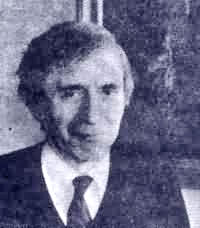
Philippe de Chérisey
To compound the confusion, Philip de Chérisey, an associate of
Pierre Plantard’s who many believe was involved in the creation of
the Dossiers secrets, later claimed that he had devised this message
and the parchments in the early 1960s.
WHAT DOES THE
MESSAGE MEAN?
Although there is no punctuation, the text naturally falls into
individual sentences and phrases. The original publication, in the
Dossiers secrets, gave the following rendering:
Bergère pas de tentation. Que
Poussin Teniers gardent la clef. Pax DCLXXXI (681). Par la croix
et ce cheval de dieu. J’achève ce daemon de gardien à midi.
Pommes bleues.
In English:
Shepherdess no temptation. That
Poussin [and] Teniers keep the key. Peace 681. By the cross and
this horse of God. I finish off this guardian daemon at midday.
Blue apples.
Gardent la clef is often translated as
’hold the key’, but this introduces a double meaning that doesn’t
work in French and which could lead English-speaking researchers
astray. For example, it has been suggested that it is a reference to
a painting of someone holding a key. Garder means ’to guard’ or
’to
keep’, but not literally ’to hold’.
J’achève means ’I complete’ or, euphemistically, ’I kill’. Most
commentators take the latter meaning, but here it is translated ’I
finish off’, as this covers both interpretations.
Although midi means both ’midday’ and ’south’, the most likely
reading of à midi is ’at midday’.
Working out the meaning of entire message has exercised many minds
for decades. The usual interpretations of the individual references
are:
-
Shepherdess: A reference to Nicolas
Poussin’s painting The Shepherds of Arcadia
-
No temptation: A reference to David
Teniers’s painting The Temptation of St Anthony
-
Poussin and Teniers: Reinforces the
above references
-
Peace 681: Sigebert IV, the
Merovingian survivor, was said to have brought to Rennes-le-Château
in the year 681
|
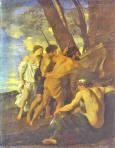
Nicolas Poussin’s The Shepherds of Arcadia |
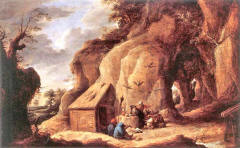
David Teniers’s The
Temptation of St Anthony
(after
1640) |
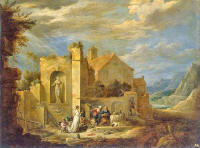
David Teniers’s The
Temptation of St Anthony (ca. 1650s) |
.The other references, to
’the cross’,
’the horse of God’, the ’guardian demon’ - and especially
’blue
apples’ - are open to many interpretations.
The most surreal and enigmatic phrase, ’blue apples’, may be a
reference to a phenomenon that occurs in Rennes-le-Château church in
mid-January (i.e. around 17 January). As the low winter sun shines
through one of the stained-glass windows, blue shapes, resembling
apples, are projected onto the wall of the church
(click below image).

A Midi Pommes Bleues
(Blue Apples at
Midday)
Photo taken at 12:45pm in the church at Rennes le Chateau
on 17 January 2005
THE MYSTERY
What was the purpose of the parchment? The possible answers to this
question are:
1. The parchment really is
one of the collection that Saunière found, and conveys some
genuine, if enigmatic, information that presumably makes sense
to certain initiates.
2. Saunière did find parchments, but the published
versions are misinformation, created later in order to lead
researchers away from the real ones.
3. The parchments, and the story that Saunière found
them, are a fabrication, but intended to make public genuine
esoteric information.
4. The parchments are part of an elaborate hoax, the
motive for which is unknown, and contain nothing of value.
Go Back
Hidden Secrets
of the Blanchefort Tombstone
and
The
Sauniere Parchments
by Tracy R. Twyman
from
HiddenMysteries Website
One of the foremost clues in the Rennes-le-Chateau
mystery is the Blanchefort tombstone. On the sides of the stone, as
we know, the message "Et in Arcadia Ego" is inscribed, using a
mixture of Greek and Latin letters. Potential interpretations of
this phrase are analyzed at length in the article "The Real Meaning
of ’Et in Arcadia Ego". It is also interesting that the word "Arka"
is used in certain apocryphal accounts of the life of Cain to denote
the region to which Cain and his descendants were banished by God,
and its location was said to be in the center of the Earth.
And the
word "Arcadia" applies to the Greek notion of Paradise and the
Golden Age, while the word "Etin" (the first four letters in the
phrase) was once an alternate spelling of "Eden", the
Judeo-Christian notion of Paradise and the Golden Age. But on the
Blanchefort tombstone, the message actually reads:
"Et in Arx Adia
Ego."
The words "Arx" and "Adia" are separated so as to emphasize "Arx."
This word, in Latin, means "a fortress, citadel, or stronghold."
Thus, this message may be specifically referring to a man-made
structure, perhaps a temple, buried beneath Rennes-le-Chateau. This
leads us directly to the message "Reddis Regis Cellis Arcis" in the
center of the stone.
The word "Reddis" is supposed by most
researchers to be derived from the old name of Rennes, which was
once called "Rhedis", "Redis", or "Rhedae." Meanwhile, "Rennes"
means "reins", and may perhaps be a name derived from the belief
that Cain was imprisoned or shackled within the Arka. But "reddis"
is also a Latin word meaning "you return" or "you restore", from
which the French "rendre" and the English "render" are derived.
"Regis" means "royal, "Cellis" means "a basement or cave", and "Arcis"
means the same thing as "Arx": a fortress, or an "ark", in the sense
of a box or enclosure.
Thus the statement being made here is "Return to (or Restore) the
Cave of the Royal Ark." The words at the bottom of the stone, "Prae-Cum",
imply the notion of "before time", or "the time before", indicating
the Golden Age. The octopus symbol below it, as we have learned from
the Priory of Sion itself, represents "the primitive solar religion
of Atlantis" - that it, the primeval religious tradition that
defined the Golden Age.
Even the person whose grave the stone was
supposedly made for, Marie de Negre de Blanchefort, whose name means
"Black Marie of the White Fort", appears to be used in this context
as a symbol of the goddess archetype of Isis, queen of the Golden
Age.
The Blanchefort
Tombstone
The letters "P" and "S" are at the top
of the stone, surrounded by a Fibonacci spiral. The same "P", "S",
and spiral can be found at the bottom of Sauniere’s first parchment.
These letters, presumably, stand for "Priory of Sion." At the bottom
of Parchment Two, the word "SION" is spelled backwards, and the "O"
has a dot in the middle, causing it to resemble the astrological
sign for the Sun.(1) As I looked at these clues again, I began to
see the secret which these clues pointed to. A pertinent line from
Le Serpent Rouge reads:
"I pivot, looking from the rose from P to
that of the S, then from the S to P"
I wondered if this line, the
"P", "S", and spiral, as well as the word "SION" spelled backwards
were all clues telling me to transpose the letters in the words "Prieure
de Sion."
I eliminated the article "de" and with little effort, came up with "Pieurrenois",
which, when pronounced with a French accent, would sound very much
like "Pyrenees." It then occurred to me that the pronunciation of "Prieure
de Sion" could be altered just slightly to sound like "Paradision."
Does this mean that the term "Prieure de Sion" is itself a clue
indicating the idea of Paradise (the Garden of Eden) and the true
Mt. Sion (the metaphorical World-Mountain in the center of the
Earth) are located in the Pyrenees? It certainly seems so.
Parchment 1
The message of the second parchment also
took on an enhanced meaning now that I knew what I did. The words
"Shepherdess - No Temptation; that Poussin and Teniers hold the key"
are perhaps the most straightforward aspect of the message.
"Shepherdess" and "Poussin", as we know, refer to
Poussin’s
painting, The Shepherds of Arcadia.
The "key" that Poussin has
embedded into this painting is the imagery of the tomb and Arcadia,
coupled with the landscape that clearly matches that of Arques, near
Rennes-le-Chateau, and of course, the hidden pentagram. So the
painting is telling us that the sacred "Arka", the tomb of a
long-lost god, is located near Arques, and within a pentagram - the
mountains of Rennes-le-Chateau - and is the location of Paradise, or
Arcadia.
The David Teniers painting mentioned by the parchments is assumed by
Henry Lincoln to be Saint Anthony and Saint Paul
(click below image), the only Teniers
painting featuring Saint Anthony which does not show him enduring
his famous temptation by demons - thus the words "no temptation."
In this painting, the two saints are sitting in front of an altar
upon which stands a crucifix and a skull.
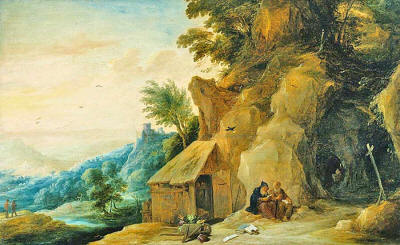
 This indicates the nature of
the tomb depicted in the Poussin painting.
(click image right) This indicates the nature of
the tomb depicted in the Poussin painting.
(click image right)
The image of a skull and
a crucifix obviously implies Golgotha, and the fact that the
life-size skull dwarfs the miniature crucifix implies the giant
skull of Adam after which Golgotha, the location of the
Cave of
Treasures, was originally named.
The painting shows one saint
pointing up towards a descending dove that is carrying the holy
host, a representation of the Grail stone.
Parchment 2
What does "Pax 681" mean? I have heard
an explanation of it from someone who claims inside knowledge, but
since I have no confirmation of this, I will leave it unreported for
now.
"By the Cross and this Horse of God" is a little less decipherable.
The cross was, like the octopus, an ancient sun symbol dating back
to Atlantis, and was also used to denote the pole, or center-point
of the Earth. The horse was a symbol of Poseidon, or Dagon, who was
thought to be an incarnation of the Sun, and the Sun was often seen
by ancient man as a chariot drawn by celestial horses.
Le Serpent Rouge also makes mention of
"divine horsemen of the abyss." Are we talking about the "abyss" of
the celestial sea? Or the abyss of the Cave of Treasures? Both
possibilities seem likely. "I destroy this demon guardian at midday"
may tie in to the notion of the cataclysm that destroyed the Golden
Age, sometimes represented as the slaying of a dragon. Midday, as we
have seen, has had ritualistic significance in the religious life of
man for thousands of years, because it was when the Sun was at its
highest point.
The term "blue apples" has been explained by previous authors as an
idiom used locally in Southern France to refer to grapes, and
therefore, its use in the parchments is a reference to the symbol of
the vine, representing the bloodline of Christ. But there is perhaps
another level of meaning as well. The Fall from the Garden of Eden
was supposedly caused by Eve eating a forbidden fruit, usually
depicted as an apple, from the Tree of Life. Therefore, the apple
symbolizes the sin that caused the Fall, and as we have said, we
believe that the story of the Fall represents the same historical
event as the Deluge.
The Flood was God’s retribution for the sins of Cain and his
descendants, who were unlawfully breeding with the "daughters of
men" (or in some versions, the "daughters of Seth.") Also, according
to some scholars, Seth and Abel were in fact the same person, which
does indeed seem to be the case when the relevant chapters of
Genesis are examined. L.A. Waddell believes that the symbol of Eve’s
apple is tied into this.
That is, they were unlawfully mixing their
sacred, royal blood with that of commoners. So this, then, is the
sin that the apple which Eve ate actually represents. And since
royal blood is referred to often as "blue blood", is seems to me
that the words "blue apples" are referring specifically to the
sinful breeding practices that are thought to have led to the
Fall/Deluge.
Other details about the parchments stick out as well. For instance,
the words "Rex Mundi", meaning "King of the World", are embedded
into Parchment One, indicating the Devil, or Cain. Then there are
the words "Redis Bles" and "Solis Sacerdotibus" written beside the
main message of Parchment One.
The way Henry Lincoln and other
authors choose to interpret this, "Redis" means "Rennes", and "Bles"
means "corn", which is what wheat was called in Europe and England
prior to the discovery of maize, now also called "corn", in the New
World. "Bles" ("corn") is also a local idiom for "money" or
"treasure", like "bread" is in English. "Solis" means "solely", and
"sacerdotibus" means "initiated."
Lincoln thus reads the message as saying,
"The treasure of Rennes is
only for the initiated."
But as we have established, "Redis" also
means "return", and wheat ("corn") was also a symbol of
Cain, who
was thought to be the inventor of the plough, and the first to
introduce the crop’s cultivation. In fact, Cain’s name actually
means "grain." Furthermore, wheat, and the bread that is made from
it have been important icons in religious rituals throughout
history, ranging from the Greek and Babylonian mysteries to ancient
Judaism and modern Christianity.
Catholics celebrate communion by
eating a wafer that represents Christ’s body, and the ancient Jews
had a special "shewbread" that was only administered to the Levitic
caste of priests during certain rituals. "Solis" also means "Sun",
and "sacerdotibus" specifically means "priesthood."
Thus, "Redis Bles Solis Sacerdotibus" could be translated in any of
the following ways:
"Return the corn to the priesthood of the Sun"
"The corn of Rennes is for the priesthood of the Sun"
"The corn of Rennes is only for the priesthood" or
"Return the wheat solely to
the priesthood"
We do appear to be on the right track with this interpretation, for
the very text into which the code of Parchment One has been inserted
is a conglomeration of quotes from three of the Gospels describing a
scene in which Jesus and his disciples are walking through a
cornfield, eating corn! As The Gospel of Saint Matthew describes it:
"At that time Jesus went on the sabbath day through the corn; and his disciples were an
hungered, and began to pluck the ears of corn and to eat. But
when the Pharisees saw it, they said unto him, Behold, thy
disciples do that which is not lawful to do upon the sabbath
day.
But he said to them, Have ye not read what David did, when
he was an hungered, and they that were with him; How he entered
into the house of God, and did eat the shewbread, which was not
lawful for him to eat, neither for them which were with him, but
only for the priests? Or have ye not read in the law, how that
on the sabbath days the priests in the temple profane the
sabbath, and are blameless? But I say to you, that this place is
one greater than the temple."
So this is the "corn" that is "only for
the priesthood." But what lies beneath the symbolism of this story,
and what statement is being made by connecting it with the phrase "Redis
Bles Solis Sacerdotibus"? Is the parchment’s creator saying,
"Return
the sacraments of the church (the true church in the tradition of
Atlantis) to its rightful priests"?
And what of the last line in the
passage from Matthew: "This place is one greater than the temple"?
If its use in the parchment is a reference to Rennes-le-Chateau,
this could mean that Rennes-le-Chateau is a much holier place than
the remains of the temple in Jerusalem. There may even be a message
buried in the reference to King David sharing in the shewbread of
the priests - a comment on the fact that Christ was seen as both
priest and king, a product of the royal line of Judah and the
priestly line of Levi.
This may all help explain another curious message which is buried in
the text of the second parchment: "Panis ?O Sal" - the Latin words
for "bread" and "salt" separated by the Alpha and
Omega symbols. Now
"sal" could represent "sulfur", which characterizes one of the
earliest stages of the alchemical process, while bread could
represent the end result of the alchemical process, the
Philosopher’s Stone, just as the shewbread does in religious
rituals.
But why would "Panis" ("bread") be
written next to the Alpha symbol, and "Sal" ("salt") be written next
to the Omega symbol, if salt is the beginning of the process and
bread is the end? Perhaps, as we have theorized earlier in this
book, the Alpha and Omega symbols are used by the Priory of Sion to
symbolize the world before and after the Flood, or before and after
the Fall from the Garden of Eden.
The bread, then, could be seen as
a symbol of the Earth’s fruitful generation, while the salt
represents the infertility of the land experienced after the
cataclysm, when the land had been inundated with saline ocean water.
Perhaps, then, this is another level of meaning to the abbreviation
"P.S." - "Panis Sal."
There is yet another hidden message embedded in Parchment Two as
well: "Areth Adgenes." Henry Lincoln has chosen to recombine these
words into "Ad Genesareth", meaning "Towards Genesareth", the latter
being a town on the coast of the Sea of Galilee (an inland lake
where many New Testament stories took place). Indeed, the Sea of
Galilee is sometimes called "Lake Genesareth."
But since the words
were split up in the parchment in a particular way, it seems to us
that were meant to look at the meaning of the individual syllables.
"Genes" could be short for "Genesis", while "Areth" could be taken
to mean "Ararat." The word "genesis" means "beginning" or
"generation." "Ararat" means "high holy place", and of course
indicates the mount upon which Noah was saved from the Flood. So we
could recombine the phrase to say "Ad Genes Areth", which would
basically mean,
"Towards the high holy place where
civilization was begun, and ultimately saved from annihilation."
The code of Parchment Two is made using
a passage from The Gospel of Saint John, Chapter 12, verses 1-7.
Shortly after Christ raises Lazarus from the dead, he is having
dinner with Mary of Bethany (thought by some to be the same as Magdalen), Martha, Lazarus, and his disciples. Mary takes "a pound
of ointment of spikenard, very costly", and anoints Christ’s feet
with it, "wiping his feet with her hair." Judas Iscariot, disgusted
at the waste of something so valuable, remarks,
"Why was not this ointment sold for
three hundred pence, and given to the poor?"
The passage continues:
"This he said, not that he cared for
the poor; but because he was a thief, and had the bag, and bare
what was put therein. Then said Jesus, Let her alone; against
the day of my burial hath she kept this. For the poor always ye
have with you; but me ye not have always."
The scene this passage describes is also
illustrated in a stained glass window on the ceiling behind the
altar of Sauniere’s church. What could its significance be in this
context? The anointing of Christ’s feet by Mary has been described
by some authors as the ritual anointing of a king by his bride and
queen, which we find perfectly reasonable. But Jesus specifically
says that, "against the day of my burial hath she kept this",
indicating that it was meant to anoint his dead body before it was
placed in the tomb. Was this tomb in Rennes-le-Chateau?
Endnote:
(1) The letters "SI", in this
instance could actually mean "IS", or Isis, while "ON" is
another name the Egyptians used for Osiris.
Go Back to Renne-le-Chateau
or
Go Back
to Tracy Twyman
|









